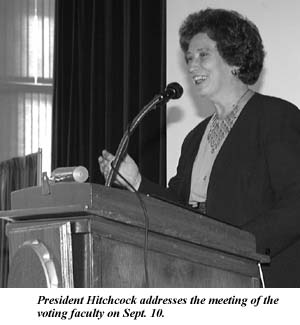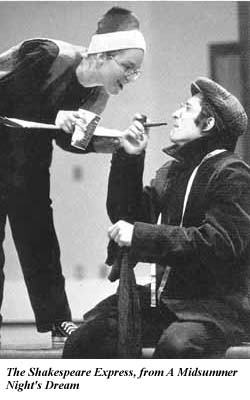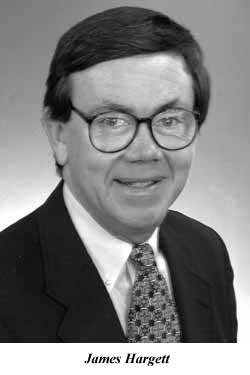President Calls for New Commitments to an Enhanced Learning Environment and Better Enrollment Trends
 By Vinny Reda
By Vinny Reda
President Hitchcock discussed the latest fiscal and policy environment that will impact the University’s most important planning initiatives and decisions for the future, and dealt with the issue of critical enrollment challenges in her address to the Fall Meeting of the Voting Faculty on Sept. 10 in the Campus Center Ballroom
The President called the past summer “remarkable,” “productive,” and “successful,” citing the moving forward with several major planning initiatives, including the dedication of the CESTM building.
“Perhaps most important of all, we have seen our year-long advocacy efforts with the Legislature and Governor’s Office come to fruition in support of many of the superb programs of our faculty,” she said.
She pointed to the victories in the state budget, passed this August: the restoration of recommended reductions in the University’s base budget; the full funding of the Tuition Assistance Program; a new Center for Minority Health Training and Research Education based in the School of Public Health; the School of Social Welfare’s participation in the State’s $2.5 million Caseworker Education Program; and the Trustees’ approval of a $1.5 billion operating budget plan for SUNY’s state-operated campuses, with a $34.4 million increase in state aid — “the first such increase, without a corresponding reduction in operating funds, in nine years . . . Indeed, our operating budget has actually increased by some 1.7%.
“In addition to stabilization of our 1997-98 operating budget, I am also most pleased to report that many of the special Legislative initiatives we proposed have also been approved, and those that weren’t are positioned well for funding in the next fiscal year.”
She thanked David Gilbert, Director of Governmental Relations, for his work in helping to ensure $10 million for the expansion of the CESTM facility, the new wing to house a microelectronics pilot manufacturing/workforce training facility.”
She took special note of a state allocation of $100,000 to support efforts to increase international programs at Albany. “Clearly,” she said, “our global society, the internationalization of our economy, and the ever-increasing movement of the world’s populations will have a profound impact on the kinds of knowledge and skills our students must possess. As I stated in my inaugural address, our curriculum should address this reality.
“Let us set as a goal that within five years, 10% of our graduates will have participated for at least a semester in an exchange program in a country where English is not the native language. The initial funds committed by Assembly Education Committee Chairman Sullivan will enable us to staff such an initiative.” She said the effort will be led by economics professor Carlos Santiago as part of his new role as Associate Vice President for Academic Affairs.
Hitchcock voiced optimism over the view of Albany inherent in the budget allocations, but also in the opinions of SUNY officials — including SUNY Con-struction Fund’s pledge to meets Albany’s Master Plan goal of $100 million in construction and rehabilitation for the next five years . She added that, in discussions over the last several months with the Chancellor, Provost and Board of Trustees chairman, it was clear to her that the University is “a pivotal element in their vision to enhance the national visibility of the State University of New York.”
Furthermore, she said, “there is, in my opinion, no reason we should not be able to fulfill our goal of achieving Research I status. There is, in fact, no reason we should not aspire to be elected to membership in the prestigious Association of American Universities — something that the Chancellor has recommended and supports for us as we continue to grow.”
Budget negotiations for 1988-89 include another exciting pros-pect, she said. “One of the most dramatic changes under consideration involves the budget process. If the current proposal known as the RAM, or Resource Allocation Methodology, is approved, the only moneys allocated to the campus will be State tax dollars.
“All other revenue streams, such as tuition, will remain, in their totality, on the campuses which generated them. This is very good news. Clearly, since State tax dollar support will probably not increase in any major way, we must be creative and diligent in designing programs which will enhance these different revenue streams. Importantly, however, under the RAM proposal, we ourselves would control all such new revenues.”
But she cautioned that it is also clear that methods being proposed to allocate State tax support will be driven ever more by campus enrollment. “We can not afford to overlook this critical aspect of our fiscal environment.”
Gaining external recognition, she said, will come above all from continued efforts to enhance the learning environment. “Clearly, the quality of our learning environment here at Albany will continue to be shaped by the quality of the faculty. Our challenge is two-fold: to continue to renew ourselves through ongoing recruitment of the best possible faculty colleagues and, equally important, to provide an environment which supports the retention of our faculty of excellence — an environment which supports their research and educational programs and facilitates their development as teacher/scholars.”
Provost Genshaft, she said, will initiate at least 20 new faculty searches during this academic year. “We have lost some 15% of our faculty in the past ten years, and we must continue to reverse that trend. Indeed, given the fact that the Master Plan for our facilities expansion is predicated on a gradual increase in our student body to a total of 20,000 by the year 2006, we must clearly prioritize faculty recruitment and retention over the next several years.”
She pointed out that, to further address the goal of enhancing the environment for research and scholarship as recommended by the Research Council of the University Senate, Albany will this year begin allocating a portion of the revenues from campus indirect cost recovery to deans, departments and centers in support of the research activities of faculty. To begin the Program, 10% of the campus’ indirect cost recovery revenues will be allocated, with 20% of these funds going to the dean or, in the case of certain centers, to the Vice President for Research, to support college- and campus-wide research initiatives, and 80% to the department or center. “This allocation represents a 400% increase over the current allocation of indirect cost revenues to the various academic units,” she said.
The President updated progress in student recruitment: SAT scores up 16 points for traditionally admitted freshmen; the Presidential Scholars program increasing to a high-water mark of 175 students (average combined SAT scores 1330, median high school average 93); newly employed strategies such as a telecounseling program; and distinguishing initiatives such as Project Renaissance, which has all 384 slots available filled, with a waiting list of some 100 students.
Yet Hitchcock said that Albany must face the continuing challenge of increased attrition rates between the freshman and sophomore years. “Indeed, our shortfall in total undergraduate enrollment, while small, is due almost entirely to this troubling phenomenon,” she said. “We must seek to understand and permanently reverse this trend.”
Toward this end, she said, Provost Genshaft has appointed a University-wide Faculty Task Force on the Quality of Academic Life and Undergraduate Student Retention, chaired by Dean John Pipkin and focusing on the array of issues that impact a student’s academic experience, especially in the freshman year.
“Most reports in the literature clearly indicate that the single most important factor affecting student retention is the quality and quantity of student-faculty interactions — both within and outside the classroom,” she said. “We need to address this issue head on.”
But, reiterated, “allocation of state tax dollars will be driven more and more by enrollment. Hence, our ability to not only recruit but retain a student body of quality will, quite simply, determine the future of our institution. We need to examine the role of faculty as student mentors. We need to reinforce quality teaching at all levels, but particularly in freshman and introductory courses.”
While happy with the progress to date in undergraduate enrollment, she said “the enrollment challenge we face in our graduate programs is really much more significant. While new enrollments in our master’s and doctoral programs are down only slightly from last year, this represents a continuing trend which we must reverse. Non-degree enrollments are down even more substantially, a trend which began with the major tuition increase during the 1995-96 academic year. Finally, as with the undergraduate student population, we are seeing increased rates of attrition.
“Taken together, these are issues which must be analyzed with care and addressed with creativity. As a research university, we will be judged by the quality and rigor of our graduate programs. We must, in keeping with the values enunciated in our evolving Strategic Plan, invest our resources in areas of excellence and potential strength.”
She said that the review of our doctoral programs, begun last year, is proceeding on schedule. “I know,” she said, “we have the will and creativity necessary to reverse these enrollment trends.”
These are issues, she said, “which I feel must take priority during the coming year if we are to be successful in taking advantage of this very special moment of opportunity in the history of our institution.”
Sneak Preview of Shakespeare Semester Arrives Oct. 6-7 with the Express
 The College of Arts & Sciences will bring the famed Shenandoah Shakespeare Express to
Page Hall with the performances of A Midsummer Night’s Dream at 8 p.m. Monday, Oct.
6, and Henry IV, Part I at 8 p.m. on Tuesday, Oct. 7.
The College of Arts & Sciences will bring the famed Shenandoah Shakespeare Express to
Page Hall with the performances of A Midsummer Night’s Dream at 8 p.m. Monday, Oct.
6, and Henry IV, Part I at 8 p.m. on Tuesday, Oct. 7.
This is a sneak preview of the Spring '98 semester’s celebration of William Shakespeare’s works, which will include performances, workshops and staged readings — several by ACTER (A Center for Theatre, Education and Research), composed of actors from the Royal Shakespeare Company and other British troupes. Tickets to the Oct. 6- 7 Express performances will be sold in advance at the PAC and at the door at Page Hall and are $5 for students and $8 for the general public. There will be no intermission.
The globe-trotting Express, who performed at Page each of 1993-95, believes Shakespeare’s plays work best when performed under the conditions for which they were originally designed - on a bare stage surrounded by the audience on three sides sharing the same light with the actors, each of whom plays several parts. The company of 12 actors seeks to restore the original dynamic built into the language of Shakespeare’s plays by stripping away 400 years of accumulated theatrical apparatus.
A Washington Post review of the company’s performance of A Midsummer Night’s Dream called it an “irrepressibly larkish new production,” one which caused “an audience ranging from adults to elementary-school kids” to be “riveted from start to finish.”
 Appearing in Albany as part of its 1997 national tour, the company has played in 40
states and five countries since its 1988 inception, including visits to the Stadt
Neuss Shakespeare Festival in Neuss, Germany; two visits to Edinburgh’s International
Fringe Festival in Scotland; a 1993 run at the Piccolo Spoleto festival in
Charleston, South Carolina; as well as three extended runs at the Folger Shakespeare
Library’s Elizabethan Theatre in Washington, D.C.
Appearing in Albany as part of its 1997 national tour, the company has played in 40
states and five countries since its 1988 inception, including visits to the Stadt
Neuss Shakespeare Festival in Neuss, Germany; two visits to Edinburgh’s International
Fringe Festival in Scotland; a 1993 run at the Piccolo Spoleto festival in
Charleston, South Carolina; as well as three extended runs at the Folger Shakespeare
Library’s Elizabethan Theatre in Washington, D.C.
Reasoning for the coming semester devoted to the Bard is manifold, said Langdon Brown, professor and chair of the Department of Theatre and coordinator for its series of events.
“The Shakespeare Semester celebrates a body of literature seminal to English language culture and so powerful in its form that it has spread throughout the world since its composition in the late 16th and early 17th Centuries,” he said. “Shakespeare’s plays and poetry have been central to university learning for hundreds of years. And because Shakespeare’s vision of human life is so comprehensive it embraces concerns central to all disciplines and fields of learning.
“The University therefore is celebrating through Shakespeare the threads that connect us all in the enterprise of learning, teaching, and research. It is about the acquisition of knowledge for the improvement of all our lives. Central to this pursuit, and central in concern to Harold Gould, the actor and alumnus who is the donor that made possible the centerpiece of the Shakespeare Semester — the March residency of ACTER — is the presentation humans make to each other through verbal communication.
“Thus, Shakespeare’s remarkable language and the skills that have enabled performers to delight audiences with it for hundreds of years will form a major theme of the semester. We hope that the Shakespeare Semester will serve as a reminder to all of the prodigious power of the arts and humanities to enrich our lives.”
Greta Petry
Starr Foundation Donates $315,000
By Greta Petry
The Starr Foundation of New York City has authorized a donation of $315,000 over five years to the University for scholarship support for students enrolled in the BA/MBA Chinese Studies and Business Administration program who plan a career in international business.
The funds will be used to support students enrolled in this unique program (begun in September 1996), which will produce graduates who are bilingual in English and Mandarin and entering the job market with work and/or internship experience in an international company. Moneys will be used to defray the cost of tuition, room and board, and other study-related expenses, and to cover administrative costs. The program is the result of collaboration between the College of Arts and Sciences and the School of Business.
The Starr Foundation is a private foundation which funds both national and international projects. Initially, its activities focused on education, particularly the provision of scholarships in the U.S. and Asia and local assistance for international studies, community funds, and other civic organizations. The foundation’s major priority today is education, emphasizing student financial aid.
Students sponsored by the Starr Foundation will be either graduates of Fudan University in Shanghai, one of China’s premier institutions of higher learning, or University at Albany undergraduates admitted with the highest academic standing.
“We are pleased that the Starr Foundation has recognized in such a generous way the University at Albany’s commitment to producing graduates who are prepared for an influential career in the global marketplace. The BA/MBA program in Chinese and Business Administration shows what can be accomplished when faculty work across the disciplines to train our graduates to succeed in tomorrow’s workplace,” said President Karen R. Hitchcock.
 James Hargett, chair of the Department of East Asian Studies, said the Starr
Foundation grant represents “a tremendous opportunity for the University because it
helps us internationalize what we do. It’s going to provide several scholarships for
American students to go to China and for students from China to come here. This
two-lane highway of students will become increasingly important to the Department of
East Asian Studies in the coming years,” Hargett said.
James Hargett, chair of the Department of East Asian Studies, said the Starr
Foundation grant represents “a tremendous opportunity for the University because it
helps us internationalize what we do. It’s going to provide several scholarships for
American students to go to China and for students from China to come here. This
two-lane highway of students will become increasingly important to the Department of
East Asian Studies in the coming years,” Hargett said.
Candace Groudine, associate vice president for University Advancement, said, “The University looks forward to the expansion and growing prominence of this program which will be made possible with the support derived from strong corporate and foundation partnerships, such as those already forged with Towers Perrin and the Starr Foundation.”
The Starr Foundation award is the result of the University’s ongoing work with a select group of corporations and foundations, led by John Lynch, chairman and chief executive officer of Towers Perrin, and a member of the class of '70, to develop the BA/MBA program in Chinese and Business Administration and to secure funding for students. The University realizes that a strong core of executives and managers with business acumen, language skills, and familiarity with Chinese culture is central to the success of business ventures in China.
